Overview of a Keystone Small Pelagic Fish in the North-Western Black Sea: Biometry, Age and Stock Status of Horse Mackerel Trachurus mediterraneus (Steindachner, 1868)
Abstract
1. Introduction
2. Materials and Methods
2.1. Fish Sampling
2.2. Determining Biometric Parameters
2.3. Age Reading Methodology
2.4. Estimating Stock Biomass
3. Results
3.1. Population Parameters
3.2. Age Structure
3.3. Stock Status
3.3.1. Overview of Catches
3.3.2. Romanian Coastal Context
3.3.3. Total Biomass Estimation
4. Discussion
5. Conclusions
Supplementary Materials
Author Contributions
Funding
Institutional Review Board Statement
Data Availability Statement
Conflicts of Interest
References
- Dürrani, Ö.; Seyhan, K. Stock Identification of the Mediterranean Horse Mackerel (Carangidae: Trachurus mediterraneus) in the Marmara and Black Seas Using Body and Otolith Shape Analyses. Estuar. Coast. Shelf Sci. 2024, 299, 108687. [Google Scholar] [CrossRef]
- Couperus, B.; Gastauer, S.; Fässler, S.M.M.; Tulp, I.; Van der Veer, H.W.; Poos, J.J. Abundance and Tidal Behaviour of Pelagic Fish in the Gateway to the Wadden Sea. J. Sea Res. 2016, 109, 42–51. [Google Scholar] [CrossRef]
- Aydın, M.; Karadurmuş, U. Age, Growth, Length-Weight Relationship, and Reproduction of the Atlantic Horse Mackerel (Trachurus trachurus Linnaeus, 1758) in Ordu (Black Sea). Ordu Üniversitesi Bilim. Teknol. Derg. 2012, 2, 68–77. [Google Scholar]
- Dürrani, Ö. An Empirical Comparison of Sex Ratio, Condition Factor and Length-Weight Relationships in Mediterranean Horse Mackerel from the Sea of Marmara, the Middle and Eastern Black Sea. J. Anatol. Environ. Anim. Sci. 2023, 8, 492–499. [Google Scholar] [CrossRef]
- Kasapoğlu, N. Age, Growth, and Mortality of Exploited Stocks: Anchovy, Sprat, Mediterranean Horse Mackerel, Whiting, and Red Mullet in the Southeastern Black Sea. Aquat. Sci. Eng. 2018, 33, 39–49. [Google Scholar] [CrossRef]
- Özdemir, S.; Erdem, E.; Özdemır, Z.B.; Aksu, H. Monthly Monitoring of Length-Weight Relationships of Allis Shad (Alosa immaculata Bennett, 1835), Horse Mackerel (Trachurus mediterraneus Steindachner, 1868) and Sprat (Sprattus sprattus Linnaeus, 1758) from the Southern Black Sea, Turkey. Cah. Biol. Mar. 2015, 56, 25–30. [Google Scholar]
- Şahin, C.; Kasapoğlu, N.; Gözler, A.M.; Kalaycı, F.; Hacımurtazaoğlu, N.; Mutlu, C. Age, Growth, and Gonadosomatic Index (GSI) of Mediterranean Horse Mackerel (Trachurus mediterraneus Steindachner, 1868) in the Eastern Black Sea. Turk. J. Zool. 2009, 32, 157–167. [Google Scholar] [CrossRef]
- Şahin, C.; Ceylan, Y. Doğu Karadeniz’de İstavrit (Trachurus mediterraneus Steindachner, 1868)) Balığının Yaş, Büyüme Parametreleri ve İlk Eşeysel Olgunluk Boyunun Belirlenmesi. J. Anatol. Environ. Anim. Sci. 2023, 8, 69–79. [Google Scholar] [CrossRef]
- Samsun, O.; Akyol, O.; Ceyhan, T. Mortalities and Exploitation Rate of Mediterranean Horse Mackerel, Trachurus mediterraneus (Steindachner, 1868) in the Central Black Sea. Turk. J. Marit. Mar. Sci. 2018, 4, 139–145. [Google Scholar]
- Samsun, S. Growth and Mortality Rates of Mediterranean Horse Mackerel (Trachurus mediterraneus Steindachner, 1868) Catches in Southeastern Coast of Black Sea Mediterranean Horse Mackerel Mortalities, Growth. Res. Sq. 2023. [Google Scholar] [CrossRef]
- Păun, C.; Galațchi, M.; Țiganov, G.; Danilov, C.; Nicolaev, A.; Maximov, V.; Niță, V.; Nicolae, C.G. Growth and Age of Trachurus mediterraneus (Steindachner, 1868) on the Romanian Black Sea Coast. Cercet. Mar. Rech. Mar. 2019, 49, 116–124. [Google Scholar]
- Păun, C.; Galaţchi, M.; Popescu, A.; Vidu, L.; Pogurschi, E.; Nicolae, C.G. Age at First Sexual Maturity of Trachurus mediterraneus (Steindachner, 1868) from Romanian Black Sea Waters, Indicator of Good Status of the Population. Sci. Pap. Ser. D Anim. Sci. 2019, LXII, 371–376. [Google Scholar]
- Păun, C.; Bănaru, D.; Galațchi, L.; Marin, M.; Vidu, L.; Nicolae, C.G. Variation in Growth and Reproduction Measurements of Trachurus mediterraneus from the Romanian Black Sea Coast. Agrolife 2020, 9, 212–219. [Google Scholar]
- Păun, C.; Țiganov, G.; Galațchi, M.; Grigoraș, D.; Danilov, C.S.; Bănaru, D.; Nicolae, C.G. Spatio-Temporal Variations of Length, Total Weight and Body Condition Index of the Mediterranean Horse Mackerel from the Romanian Black Sea Area. Sci. Pap. Ser. D Anim. Sci. 2024, LXVII, 614–622. [Google Scholar]
- Păun, C.; Bănaru, D.; Țiganov, G.; Galațchi, M.; Marin, M.; Vidu, L.; Nicolae, C.G. Observation Regarding the Biology Aspects of Horse Mackerel from Romanian Coast between 2018–2020. Sci. Pap. Ser. D Anim. Sci. 2021, LXIV, 479–485. [Google Scholar]
- Yankova, M.; Raykov, V.; Ivanova, P.; Djembekova, N.; Valcheva, N.; Dechev, D.; Hristova, D.; Trandafilov, P.; Bacheva, S. Biological Monitoring of Landings of Commercially Important Species. Scientific Report Covering the Results over 2017–2019; IO-BAS: Varna, Bulgaria, 2020. [Google Scholar]
- Yankova, M.; Pavlov, D.; Raykov, V.; Mihneva, V.; Radu, G. Length-Weight Relationships of Ten Fish Species from the Bulgarian Black Sea Waters. Turk. J. Zool. 2011, 35, 265–270. [Google Scholar] [CrossRef]
- Yankova, M.H.; Raykov, V.S.; Gerdzhikov, D.B.; Frateva, P.B. Growth and Length-Weight Relationships of the Horse Mackerel, Trachurus mediterraneus Ponticus (Aleev, 1956), in the Bulgarian Black Sea Coast. Turk. J. Zool. 2010, 34, 85–92. [Google Scholar] [CrossRef]
- Yankova, M. Some Biological Aspects of the Horse Mackerel Catch of the Bulgarian Black Sea Coast. Cercet. Mar. Rech. Mar. 2010, 39, 239–249. [Google Scholar]
- Yankova, M.H.; Raykov, V.S. Morphological Properties of Horse Mackerel, Trachurus mediterraneus ponticus Aleev, 1956 (Osteichthyes: Carangidae) from the Black Sea. Turk. J. Fish. Aquat. Sci. 2006, 6, 85–91. [Google Scholar]
- Yankova, M. Population Dynamics of Horse Mackerel (Trachurus mediterraneus ponticus) in the Bulgarian Black Sea Coast. Int. Sch. Res. Not. Zool. 2013, 2013, 127287. [Google Scholar] [CrossRef]
- Kutsyn, D.N. Life History of Mediterranean Horse Mackerel Trachurus mediterraneus (Carangidae) from Crimea (Black Sea). J. Ichthyol. 2021, 61, 196–205. [Google Scholar] [CrossRef]
- Carbonara, P.; Follesa, M.C. (Eds.) Handbook on Fish Age Determination: A Mediterranean Experience; Studies and Reviews; FAO: Rome, Italy, 2019; Volume 98. [Google Scholar]
- Follesa, M.C.; Carbonara, P. (Eds.) Atlas of the Maturity Stages of Mediterranean Fishery Resources; Studies and Reviews; FAO: Rome, Italy, 2019; Volume 99. [Google Scholar]
- Le Cren, E.D. The Length-Weight Relationships Andseasonal Cycle in Gonad Weight and Condition in Perch (Perca fluviatilis). J. Anim. Ecol. 1951, 20, 210–219. [Google Scholar]
- Ricker, W.E. Bulletin of the Fisheries Research Board of Canada. In Computation and Interpretation of Biological Statistics of Fish Populations; Fisheries and Marine Service: Ottawa, ON, Canada, 1975; pp. 191–382. [Google Scholar]
- Beverton, R.J.H.; Holt, S.J. On the Dynamics of Exploited Fish Populations. Fish. Investig. 1957, 19, 11–533. [Google Scholar]
- Matta, M.E.; Kimura, D.K. (Eds.) Age Determination Manual of the Alaska Fisheries Science Center Age and Growth Program; NOAA Professional Paper NMFS 13; National Fisheries Science Center, Scientific Publications Office: Juneau, AK, USA, 2012. [Google Scholar]
- Panfili, J.; de Pontual, H.; Troadec, J.; Wright, P.J. (Eds.) Manual of Fish Sclerochronology; IFREMER-IRD: Brest, France, 2002. [Google Scholar]
- Fowler, J.; Cohen, L.; Jarvis, P. Practical Statistics for Field Biology, 2nd ed.; Wiley: New York, NY, USA, 1998. [Google Scholar]
- GFCM Validated Stock Assessment Forms (SAFs). Available online: https://www.fao.org/gfcm/data/safs (accessed on 13 May 2025).
- STECF & Common Fisheries Policy. Available online: https://stecf.ec.europa.eu/index_en?prefLang=ro (accessed on 15 May 2025).
- Ivanchikova, J.; Tregenza, N.; Popov, D.; Meshkova, G.; Paiu, M.; Timofte, C.; Öztürk, A.A.; Tonay, A.M.; Dede, A.; Özsandıkçı, U.; et al. Seasonal and Diel Patterns in Black Sea Harbour Porpoise Acoustic Activity in 2020–2022. Ecol. Evol. 2024, 14, e70182. [Google Scholar] [CrossRef]
- Basilone, G.; Ferreri, R.; Aronica, S.; Bonanno, A.; Genovese, S.; Rumolo, P.; Carbonara, P.; Barra, M. Growth Variability in Atlantic Horse Mackerel Trachurus trachurus (Linneus, 1758) across the Central Mediterranean Sea: Contrasting Latitudinal Gradient and Different Ecosystems. Front. Mar. Sci. 2023, 10, 1161552. [Google Scholar] [CrossRef]
- Albo-Puigserver, M.; Pennino, M.G.; Bellido, J.M.; Colmenero, A.I.; Giráldez, A.; Hidalgo, M.; Gabriel Ramírez, J.; Steenbeek, J.; Torres, P.; Cousido-Rocha, M.; et al. Changes in Life History Traits of Small Pelagic Fish in the Western Mediterranean Sea. Front. Mar. Sci. 2021, 8, 570354. [Google Scholar] [CrossRef]
- Hilborn, R.; Buratti, C.; Díaz-Acuña, E.; Hively, D.; Kolding, J.; Kurota, H.; Baker, N.; Mace, P.M.; De Moor, C.L.; Muko, S.; et al. Recent Trends in Abundance and Fishing Pressure of Agency-Assessed Small Pelagic Fish Stocks. Fish Fish. 2022, 23, 1313–1331. [Google Scholar] [CrossRef]
- Ortega, M.; Mohamed Santamaria, S.; Zografos, C.; Mascarell-Rocher, Y.; Coll, M.; Sbragaglia, V. Past, Present and Future of Small Pelagic Fisheries in the North-Western Mediterranean Sea through Fishers’ Perceptions. Mar. Pol. 2024, 171, 106490. [Google Scholar] [CrossRef]
- Rodríguez-Castañeda, J.C.; Ventero, A.; García-Márquez, M.G.; Iglesias, M. Spatial and Temporal Analysis (2009–2020) of the Biological Parameters, Abundance and Distribution of Trachurus mediterraneus (Steindachner, 1868) in the Western Mediterranean. Fish. Res. 2022, 256, 106483. [Google Scholar] [CrossRef]
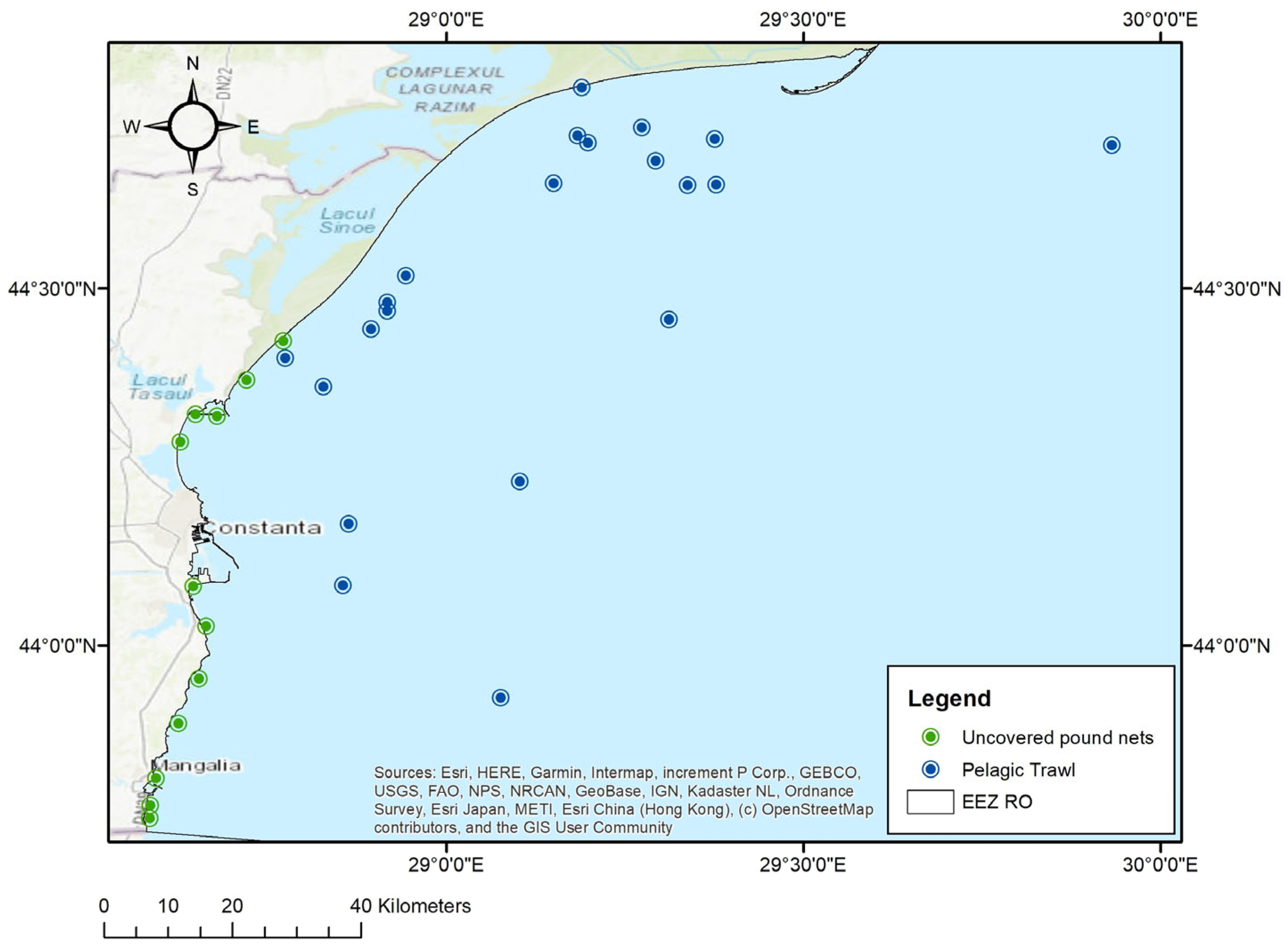
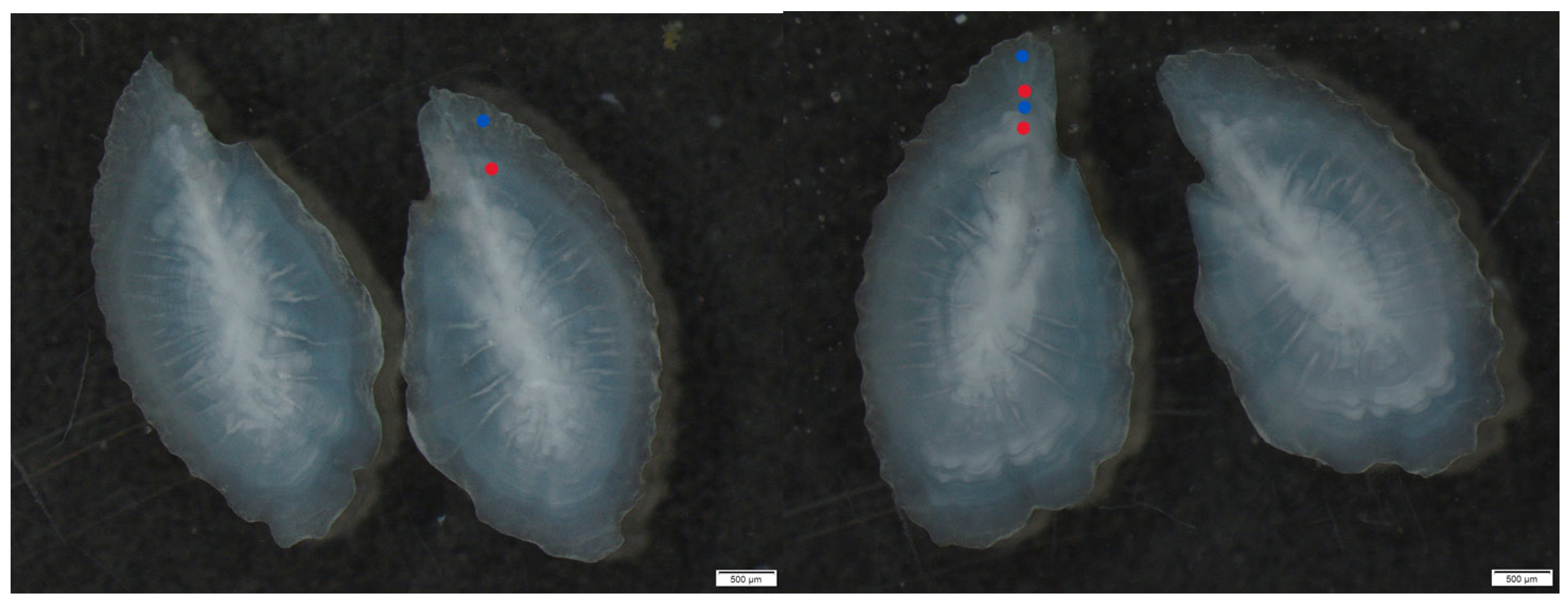
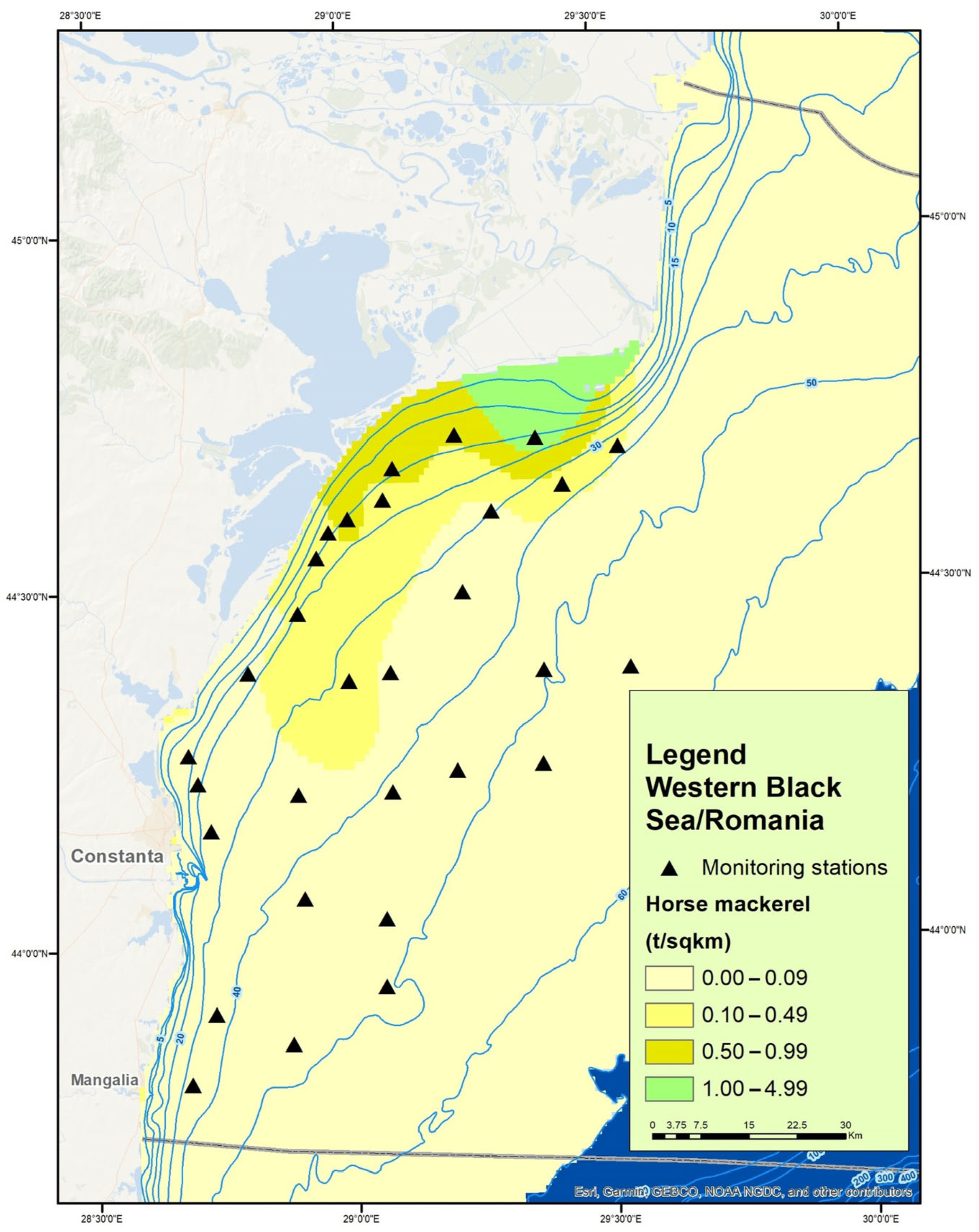
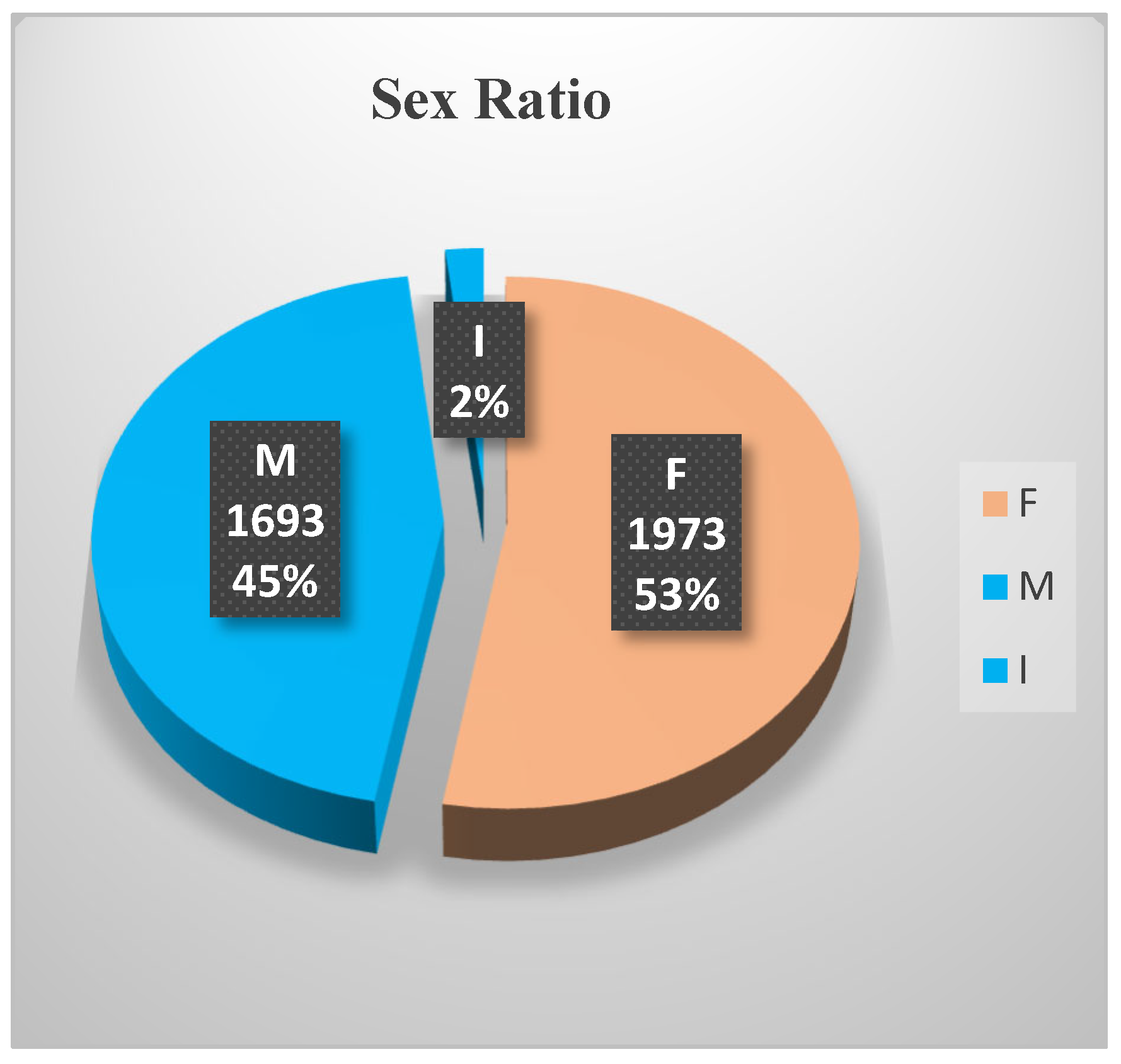
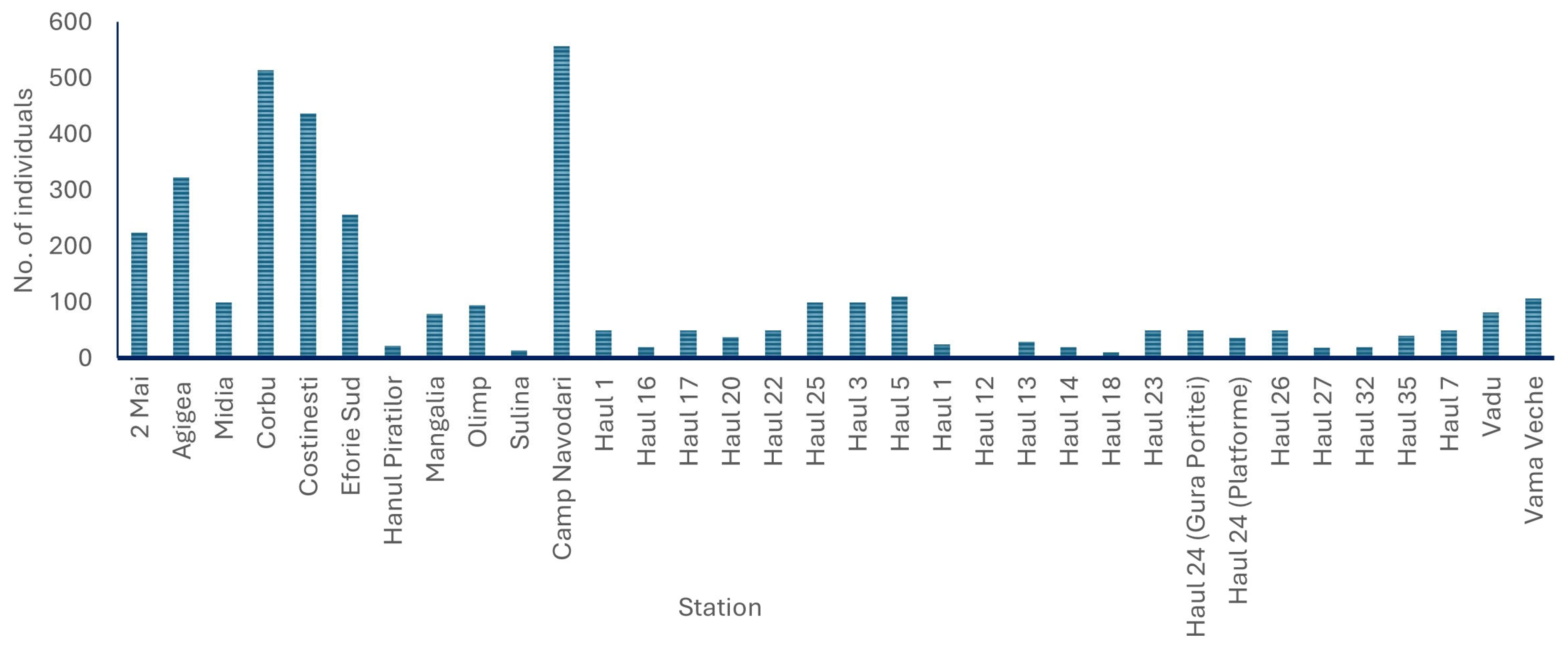
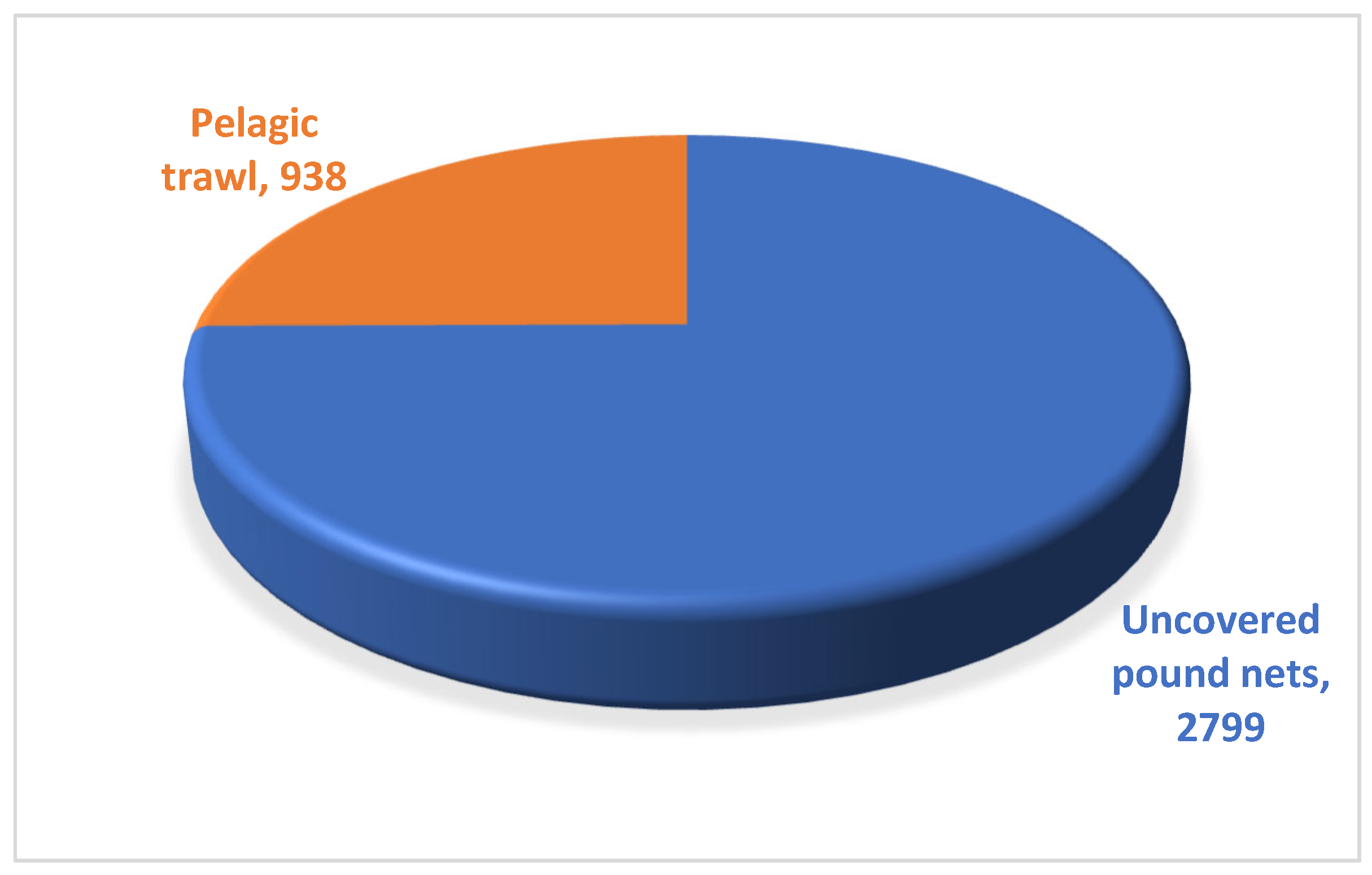
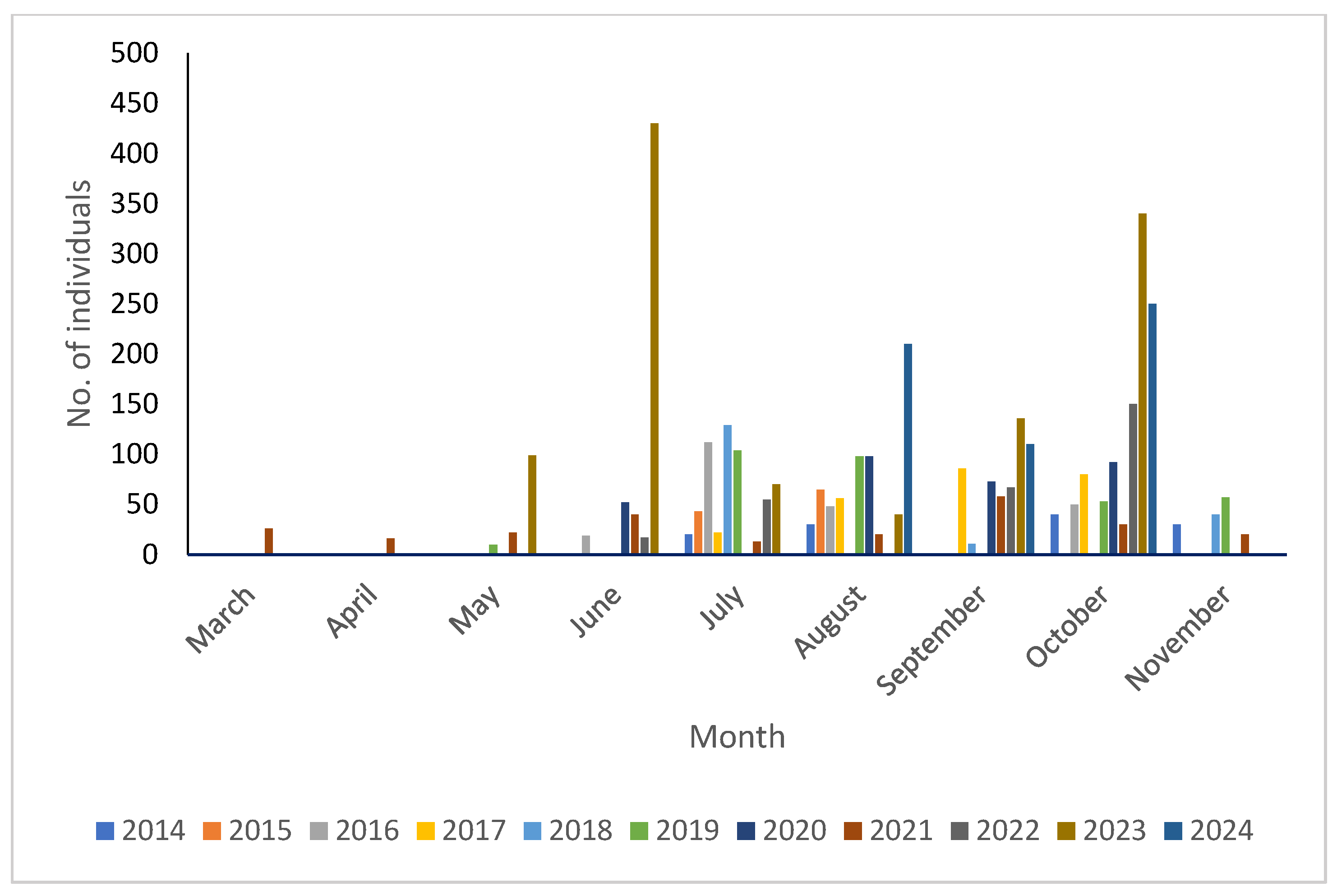
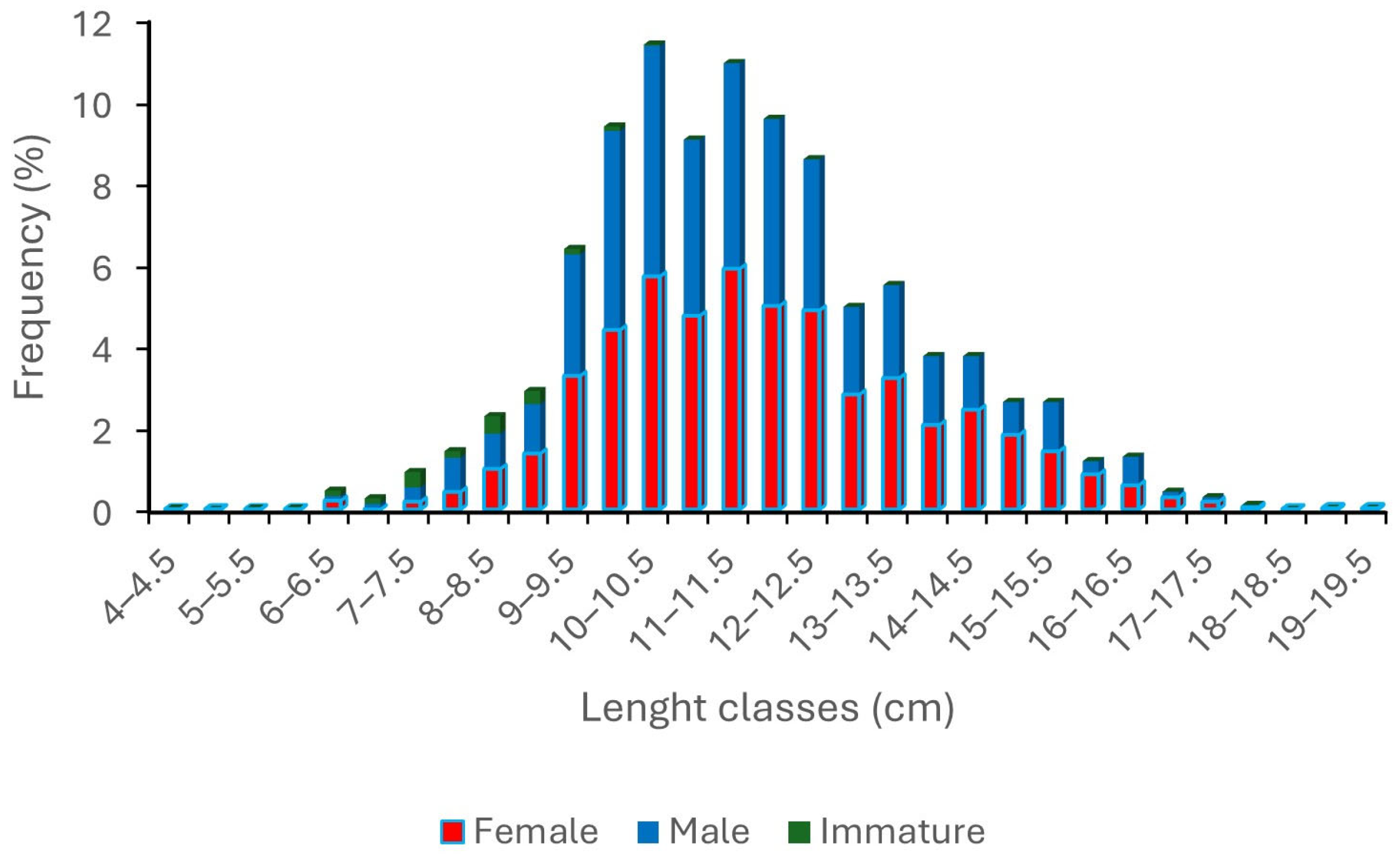
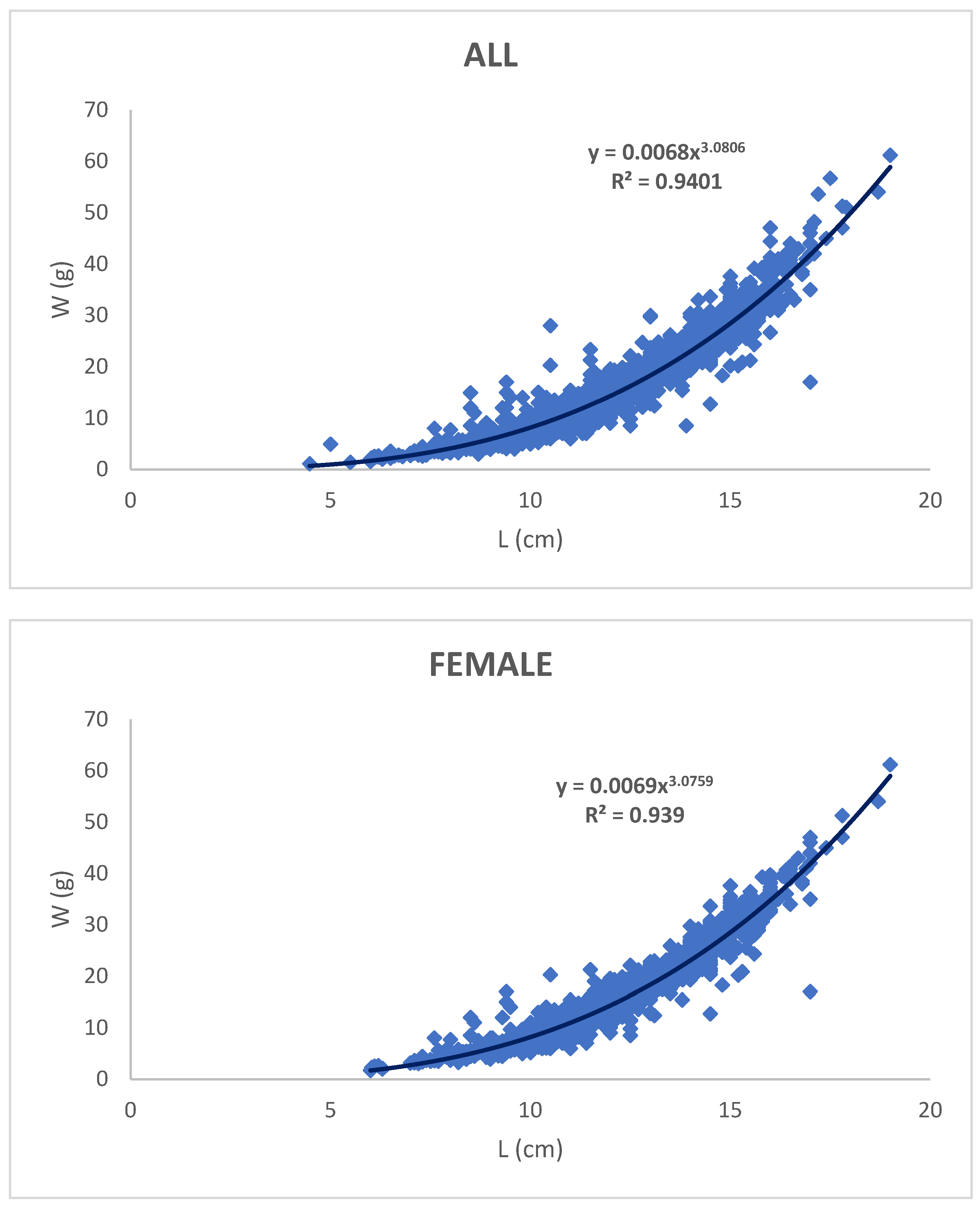
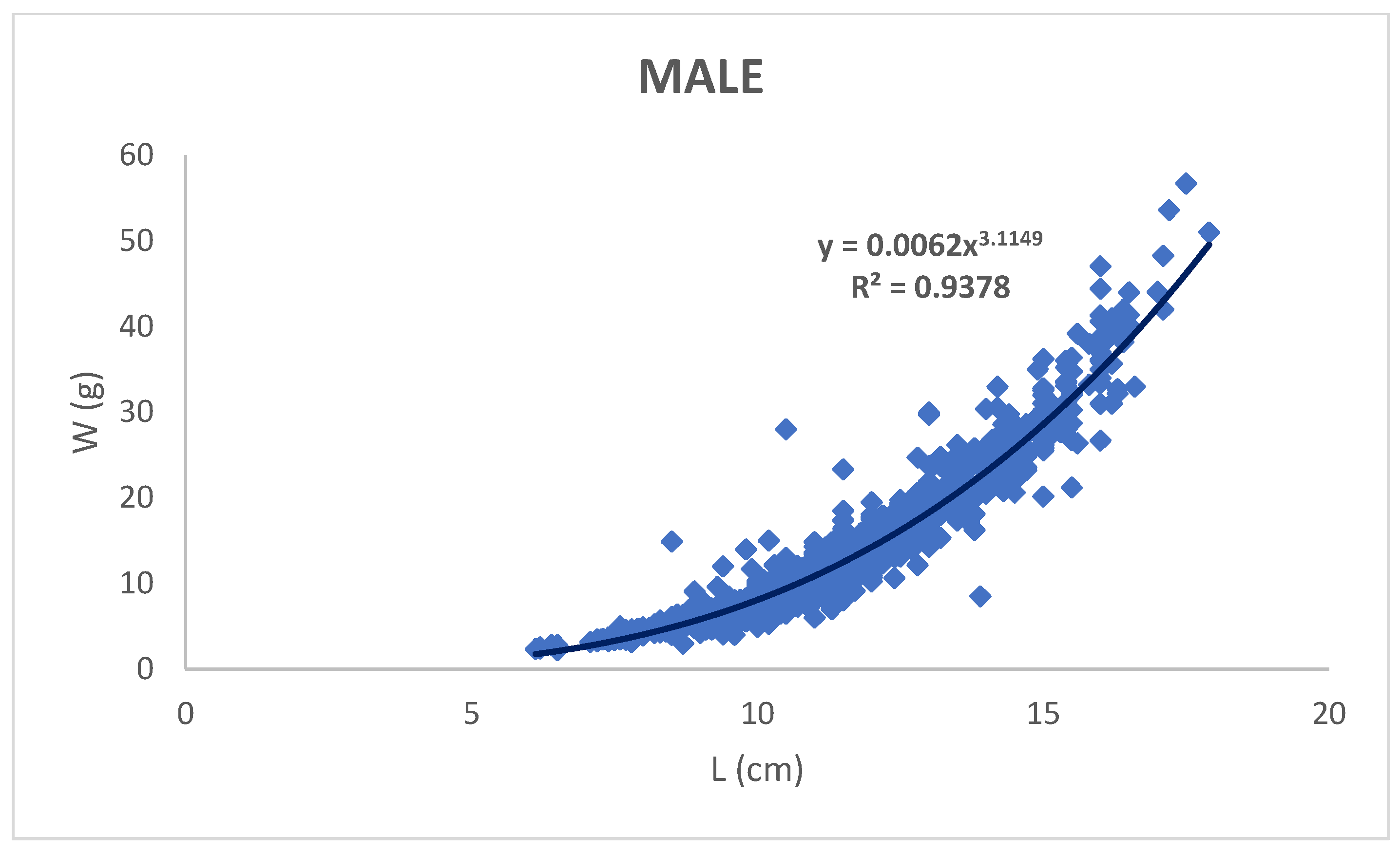
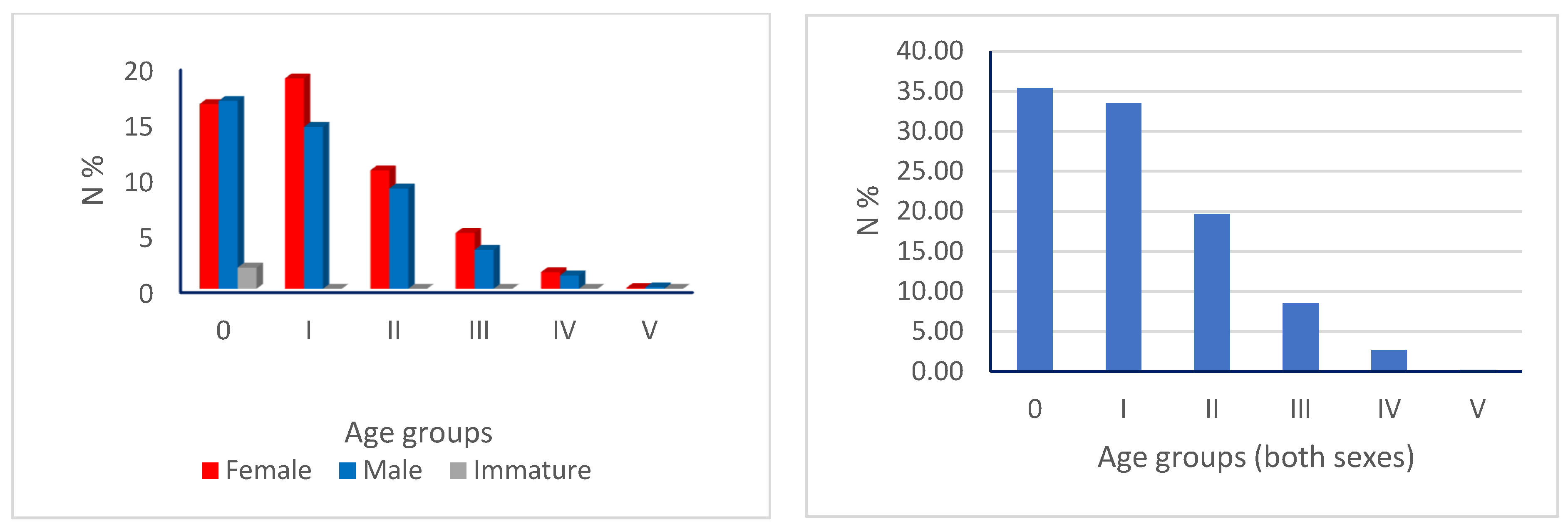
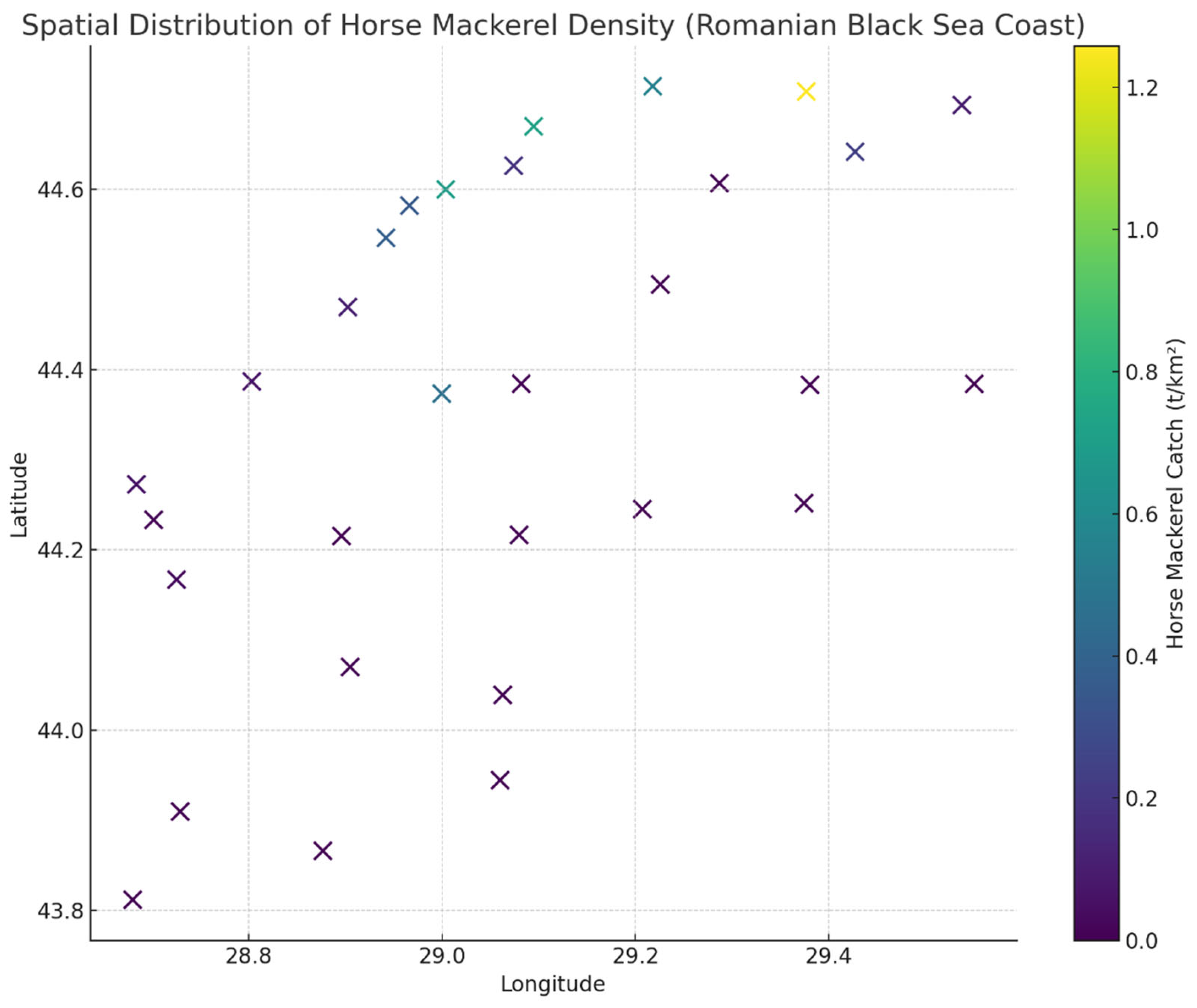
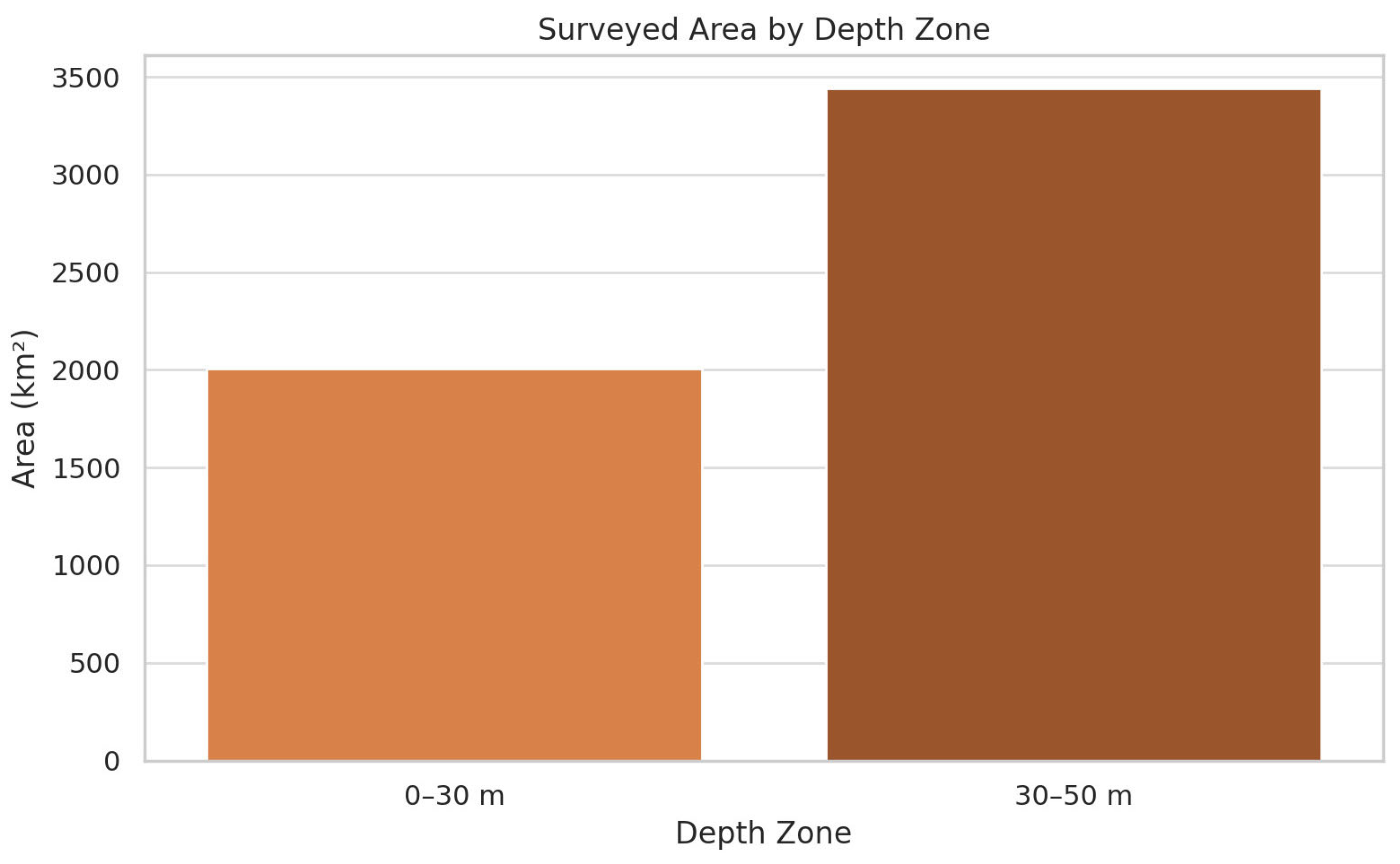
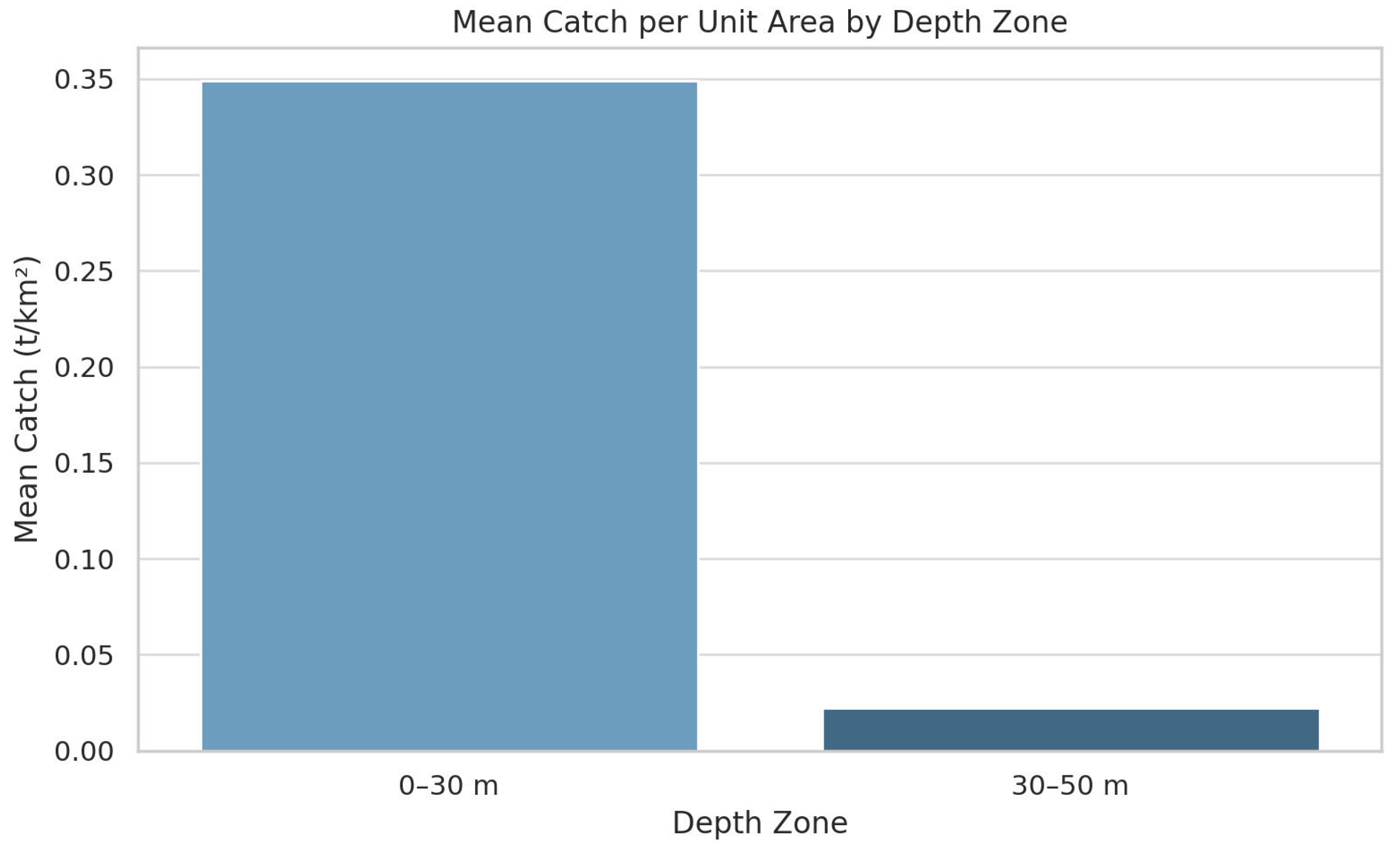
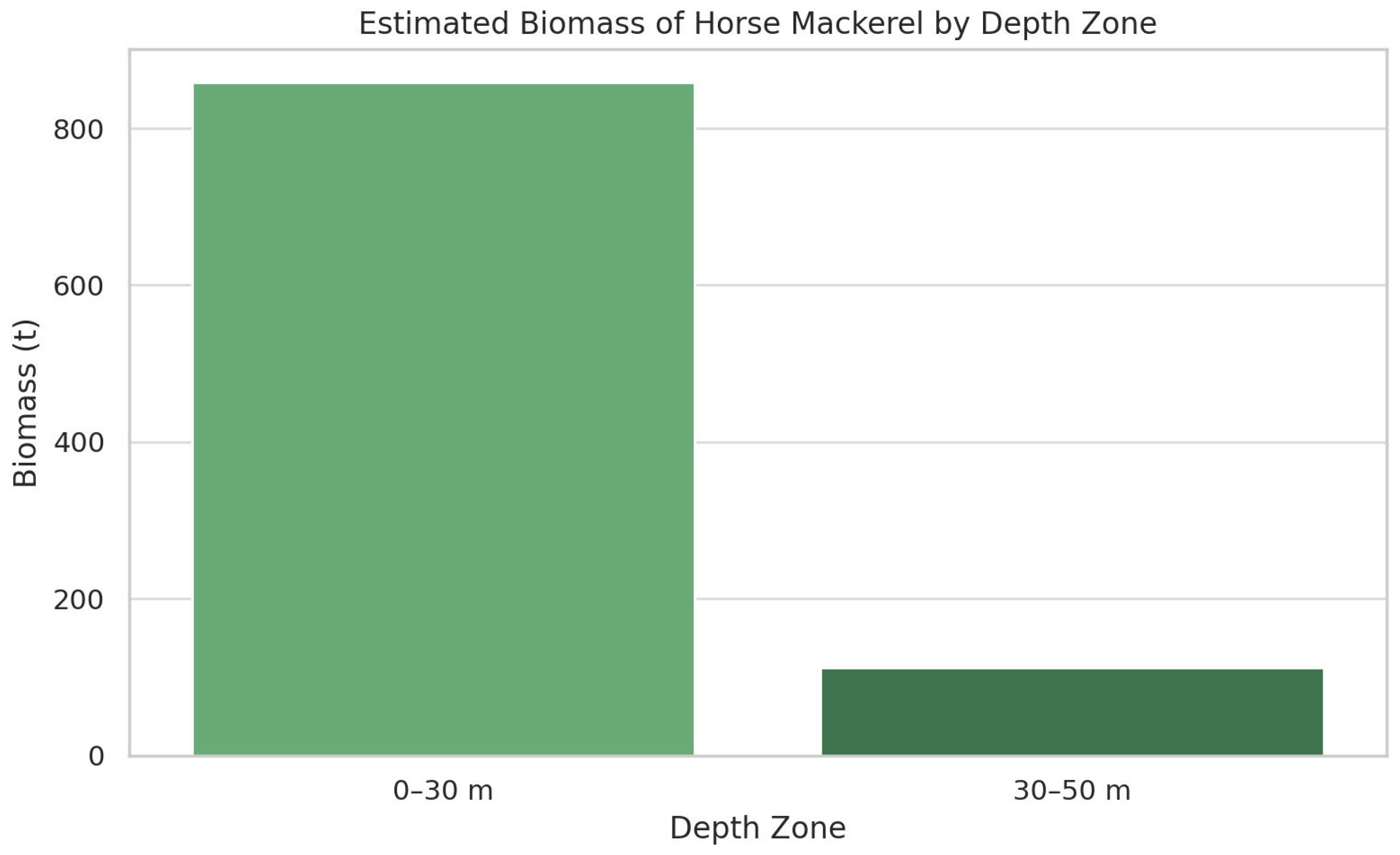
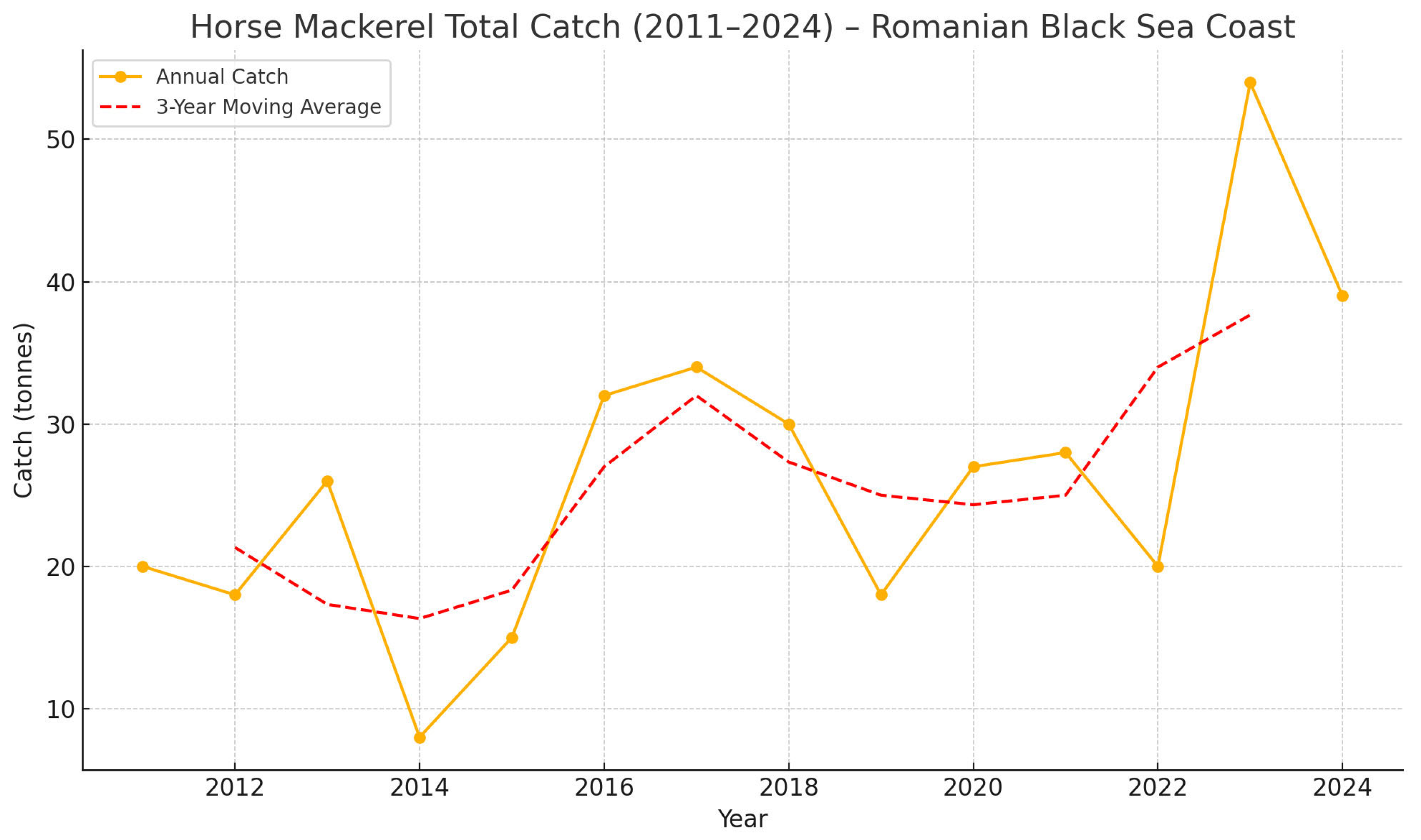
| Year | N | L (cm) + SD | W (g) + SD | K + SD |
|---|---|---|---|---|
| 2014 | 120 | 8.79 ± 1.46 | 6.02 ± 2.49 | 0.86 ± 0.09 |
| 2015 | 108 | 13.84 ± 1.24 | 22.75 ± 5.66 | 0.84 ± 0.06 |
| 2016 | 229 | 12.04 ± 1.79 | 15.69 ± 6.21 | 0.86 ± 0.11 |
| 2017 | 244 | 11.05 ± 2.78 | 14.04 ± 9.81 | 0.88 ± 0.14 |
| 2018 | 180 | 11.86 ± 1.81 | 16.42 ± 8.63 | 0.91 ± 0.09 |
| 2019 | 322 | 11.8 ± 2.13 | 15.3 ± 8.46 | 0.85 ± 0.1 |
| 2020 | 315 | 11.02 ± 2.19 | 11.95 ± 7.48 | 0.8 ± 0.2 |
| 2021 | 245 | 11.65 ± 1.57 | 13.64 ± 6.22 | 0.83 ± 0.25 |
| 2022 | 289 | 10.68 ± 2.04 | 11.64 ± 7.61 | 0.85 ± 0.06 |
| 2023 | 1115 | 11.19 ± 1.86 | 12.4 ± 8.59 | 0.78 ± 0.11 |
| 2024 | 570 | 11.26 ± 1.27 | 12.9 ± 4.4 | 0.87 ± 0.09 |
| Age | Sex | N | L (cm) | W (g) |
|---|---|---|---|---|
| 0 | I | 71 | 7.79 | 4.01 |
| F | 621 | 9.66 | 7.50 | |
| M | 631 | 9.57 | 7.16 | |
| Combined | 1323 | 9.52 | 7.15 | |
| I | F | 707 | 11.21 | 12.26 |
| M | 544 | 11.06 | 11.65 | |
| Combined | 1251 | 11.14 | 12.00 | |
| II | F | 398 | 12.83 | 18.05 |
| M | 337 | 12.54 | 16.78 | |
| Combined | 735 | 12.70 | 17.47 | |
| III | F | 188 | 14.62 | 26.68 |
| M | 131 | 14.35 | 25.65 | |
| Combined | 319 | 14.51 | 26.25 | |
| IV | F | 56 | 16.02 | 36.21 |
| M | 45 | 15.82 | 35.63 | |
| Combined | 101 | 15.93 | 35.95 | |
| V | F | 3 | 18.36 | 53.39 |
| M | 5 | 17.14 | 51.32 | |
| Combined | 8 | 17.60 | 52.10 |
| Depth Interval (m) | 0–30 m | 30–50 m | Total |
|---|---|---|---|
| Researched area (km2) | 2005 | 3440 | 5445 |
| Catch variation (t/km2) | 0.006–1.259 | 0.001–0.240 | 0.001–1.259 |
| Mean catch (t/km2) | 0.349 | 0.022 | 0.185 |
| Biomass of fishing agglomerations (t) | 858.58 | 112.10 | 969.68 |
| Biomass extrapolated to the Romanian shelf (t) 969.68 | |||
Disclaimer/Publisher’s Note: The statements, opinions and data contained in all publications are solely those of the individual author(s) and contributor(s) and not of MDPI and/or the editor(s). MDPI and/or the editor(s) disclaim responsibility for any injury to people or property resulting from any ideas, methods, instructions or products referred to in the content. |
© 2025 by the authors. Licensee MDPI, Basel, Switzerland. This article is an open access article distributed under the terms and conditions of the Creative Commons Attribution (CC BY) license (https://creativecommons.org/licenses/by/4.0/).
Share and Cite
Păun, C.; Țoțoiu, A.; Țiganov, G.; Galațchi, M.; Nenciu, M.; Niță, V. Overview of a Keystone Small Pelagic Fish in the North-Western Black Sea: Biometry, Age and Stock Status of Horse Mackerel Trachurus mediterraneus (Steindachner, 1868). Fishes 2025, 10, 390. https://doi.org/10.3390/fishes10080390
Păun C, Țoțoiu A, Țiganov G, Galațchi M, Nenciu M, Niță V. Overview of a Keystone Small Pelagic Fish in the North-Western Black Sea: Biometry, Age and Stock Status of Horse Mackerel Trachurus mediterraneus (Steindachner, 1868). Fishes. 2025; 10(8):390. https://doi.org/10.3390/fishes10080390
Chicago/Turabian StylePăun, Cătălin, Aurelia Țoțoiu, George Țiganov, Mădălina Galațchi, Magda Nenciu, and Victor Niță. 2025. "Overview of a Keystone Small Pelagic Fish in the North-Western Black Sea: Biometry, Age and Stock Status of Horse Mackerel Trachurus mediterraneus (Steindachner, 1868)" Fishes 10, no. 8: 390. https://doi.org/10.3390/fishes10080390
APA StylePăun, C., Țoțoiu, A., Țiganov, G., Galațchi, M., Nenciu, M., & Niță, V. (2025). Overview of a Keystone Small Pelagic Fish in the North-Western Black Sea: Biometry, Age and Stock Status of Horse Mackerel Trachurus mediterraneus (Steindachner, 1868). Fishes, 10(8), 390. https://doi.org/10.3390/fishes10080390











